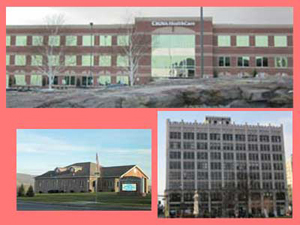Missouri Dental Providers

USA Dental Edge breaks down oral care providers by county for the convenience of the customer/patient. Use the search tools here to find care near you.
Missouri Counties
MO County List →About Missouri
Residents of Missouri find themselves in the same dilemna as people in every other state. The never-ending search for quality, affordable dental insurance for themselves or their families. Whether you live in the northeastern corner of the state near Kirksville, or the southwestern corner near Joplin, finding a value plan for your dentistry never seems to get any easier.
Along with fuel prices, food, utilities, taxes, and everything else, the costs associated with good dental care seem to keep rising. With the rise in prices comes the rise in rates for dental plans and insurance premiums.
The Show Me state is currently home to nearly 6 million people, each of whom require dental care at some point. If the market is there, the insurance companies will be too. Whether you live in the larger Missouri cities: Kansas City, St. Louis, Springfield, Independence, Columbia, Lee's Summit, O'Fallon, St. Joseph, St. Charles or the smaller towns in between, finding dental care in MO is easy if you know where to look.
Sometimes the state's latest statistics can help guide you as well. Some of the relevant dental statistics for Missouri can be found here if you are interested in more in-depth numbers to aid your research.
- Kansas City
- Springfield
- Independence
- Lee's Summit
- St. Joseph
- St. Charles
- O'Fallon
- Jefferson City
- Cameron
- St. Louis
- Joplin
- Branson
- Sullivan
- West Plains
- Maryville
Missouri Dental Statistics
It's amazing what statistics can tell us about society. Some simple data collection from everyday citizens paints a detailed picture of the state of oral health in the USA. Here are some interesting dental stats according to the Centers for Disease Control and Prevention:
- Nearly 78 percent of Americans have had at least one cavity before they reach the age of 18.
- 80 percent of the population residing in the USA has some form of gum (periodontal) disease.
- Americans make about 500 million dentist visits annually for preventive care and oral health issues
- American citizens, including residents of Missouri, spend an estimated 98 billion dollars on dental services annually
- Overexposure to fluoride is higher in adolescents than in adults, those most affected are aged 12-15
- Most adults show signs of periodontal disease, with severe periodontal disease affecting approximately 14 percent of adults
- Men are more likely than women to have more severe dental diseases including oral cancer
- Three out of every four patients don't change their toothbrush as often as is recommended
- As many as 16 percent of children between 6 and 19 and 23 percent of adults age 20 and up have untreated cavities
Some basic statistics about Missouri can put the current state of dental health care into perspective. The U.S. Census Bureau takes a census of the population every 10 years. They conduct censuses of business activity every five years. They also conduct various other surveys on an annual basis. The following data is derived from the 2020 Census as well as other surveys of business activity in Missouri.
(Stand by, detailed statistics are still being configured...)
Latest data derived from Census.org | Centers for Disease Control and Prevention
UDE is user supported. When you buy through our site, we may earn a small affiliate commission, our full disclosure is here.The State of Dental Care by the Arch
Missouri is a great state from border to border. Finding dental care near the St. Louis Arch is easily achievable, as the area is part of downtown St. Louis, which offers a range of dental practices and clinics. Here are some steps you can take to find dental care near the St. Louis Arch:
- Online Search: Start by conducting an online search for "dentists near St. Louis Arch" or "dental clinics downtown St. Louis." Search engines like Google will provide a list of dental offices in the area, along with their locations, contact information, and patient reviews.
- Dental Associations: Check the websites of local dental associations or the American Dental Association (ADA) to find directories of dentists in the St. Louis area. These directories often include dentists' specialties and contact details.
- Local Business Directories: Look in local business directories, both online and in printed versions, for dental practices near the St. Louis Arch. Yellow Pages and Yelp are popular platforms that can help you find nearby dental offices.
- Health Centers: Inquire at nearby community health centers or medical facilities if they offer dental services. Some healthcare centers provide comprehensive care, including dental, in one location.
- Recommendations: Ask friends, family, or coworkers for recommendations on dentists they have had positive experiences with in the area. Personal recommendations can be valuable in finding a reputable dentist.
- Dental Schools: If you are open to receiving dental care from dental students under the supervision of licensed dentists, consider checking if there are any dental schools in the St. Louis area that offer dental services to the public.
- Local Hospitals: Some hospitals in the area may have dental clinics or partnerships with dental practices. Check with local hospitals to see if they offer dental services.
Once you have a list of potential dental offices, you can call them to inquire about services offered, insurance acceptance, pricing, and appointment availability. When choosing a dentist, consider factors such as their experience, qualifications, office hours, and proximity to your location.
Keep in mind that the area around the St. Louis Arch is a popular tourist destination, so it's essential to plan ahead and schedule your dental appointments in advance, especially during peak tourist seasons. For the remainder of Missouri, these concepts basically hold true regardless of your location in the state.
What About Missouri's Poor Children?
Finding dental care for Missouri's children in poverty can be challenging, but there are resources available to help ensure they receive the necessary dental health services.
Poverty rates can fluctuate over time, and it's essential to refer to the most recent data from official sources for the latest information. Some of the areas in Missouri that have historically had higher poverty rates are:
St. Louis (the city of St. Louis has faced persistent poverty in certain neighborhoods, particularly in parts of North St. Louis and some areas in the south), Kansas City (similar to St. Louis, certain neighborhoods within Kansas City have experienced higher poverty rates),
Rural Areas (some rural regions of Missouri have also faced significant poverty challenges due to limited economic opportunities and resources), Jefferson County (while parts of Jefferson County, particularly the more rural areas, have experienced higher poverty rates, other areas in the county have relatively lower poverty rates), Bootheel Region (the southeastern region of Missouri, known as the Bootheel, has faced higher poverty rates compared to other parts of the state), and Joplin (located in the southwest corner of Missouri, has also experienced pockets of higher poverty).
Here are some options that families with children in poverty can explore:
- Medicaid and CHIP: In Missouri, Medicaid and the Children's Health Insurance Program (CHIP) provide health coverage for low-income children. Both programs typically cover dental services, including check-ups, cleanings, and treatments. Eligibility and covered services may vary by state, so families should check their state's Medicaid or CHIP program for details.
- Community Health Centers: Federally Qualified Health Centers (FQHCs) and other community health centers located throughout Missouri offer affordable healthcare services, including dental care, on a sliding scale based on income. These centers are present in many communities and provide comprehensive dental services for children and adults.
- School-Based Dental Programs: Some schools partner with dental clinics or mobile dental units to provide dental care on-site. These programs may offer dental exams, cleanings, sealants, and basic treatments for students in Missouri at little or no cost.
- Nonprofit Organizations: Several nonprofit organizations focus on providing dental care to underserved populations, including children in poverty. These organizations may operate free or low-cost dental clinics or partner with dentists licensed in Missouri who offer pro bono services.
- Children's Health Days: Some communities host special health events that include free dental check-ups and treatments for children. These events are usually advertised locally, so families can check community centers, schools, or social service agencies for information.
- Missouri Statewide and Local Dental Programs: Check for dental assistance programs specifically designed for children in need. These programs may offer free or reduced-cost dental services for eligible children.
- Dental Vouchers or Referrals: Social service agencies, schools, or nonprofit organizations may have dental vouchers or referral networks to help Missouri's families access dental care for their children.
Families can inquire about these resources at local health departments, social service agencies, schools, or community centers. Dental associations and advocacy groups may also provide information on available dental programs for children in poverty regardless of where they live in Missouri. Early dental care is crucial for children's oral health, and finding appropriate resources can make a significant difference in their overall well-being.
Dentists in High Crime Areas
Dental care is essential for everyone, regardless of the neighborhood they live in. However, accessing dental care in high crime areas can present additional challenges due to various factors, including safety concerns, limited healthcare facilities, and financial constraints.
That being said, crime rates can vary within different areas of Missouri. The highest crime areas in Missouri are typically found in certain neighborhoods or cities with higher population densities and socioeconomic challenges. Some cities that have been known for higher crime rates in the past include St. Louis; certain neighborhoods within the city of St. Louis have experienced higher crime rates, particularly with regards to violent crimes.
Another area of concern is Kansas City; like St. Louis, certain areas of Kansas City have faced higher crime rates, particularly in parts of the urban core. And lastly Springfield, while generally considered safer than the larger cities of St. Louis and Kansas City, some neighborhoods in Springfield have experienced higher crime rates compared to other areas in the city.
Here are some options and considerations for finding dentists in high crime areas:
- Community Health Centers: Look for community health centers or clinics in or near the high crime area. These centers often offer affordable or sliding-scale dental services, making them more accessible to residents with limited financial means.
- Nonprofit Organizations: Some nonprofit organizations operate mobile dental clinics or partner with local dentists to provide dental services in underserved neighborhoods, including high crime areas. These organizations may offer free or low-cost dental care to residents.
- Government Programs: Check with local health departments or government agencies for dental assistance programs designed to help residents in high crime areas access essential healthcare services.
- Dental Schools: Dental schools may have clinics that offer discounted services to the public, including those living in high crime areas. Dental students, under the supervision of licensed dentists, provide the treatments.
- Local Referrals: Ask social service agencies, community organizations, or local residents for recommendations or referrals to dentists who serve the community in high crime areas.
- Safety Precautions: When visiting a dental office in a high crime area, consider scheduling appointments during daylight hours to enhance safety. Additionally, inquire about any safety measures the dental office has in place, such as security personnel or controlled access to the building.
- Telehealth Options: In some cases, telehealth consultations or virtual dental appointments may be available. While this might not replace all dental services, it can be useful for initial assessments or consultations.
- Dental Vouchers: Check if social service agencies or charitable organizations offer dental vouchers that can be used to offset the cost of dental care for residents in high crime areas.
It's essential to prioritize oral health and seek dental care, even in challenging circumstances. For safety and peace of mind, consider reaching out to local organizations or community leaders for guidance on reputable dental services in the area.
About UDE
UDE is a free service designed to help place perspective patients with various oral care providers in close proximity. USA Dental Edge organizes oral care providers primarily by county (or parish when applicable).




